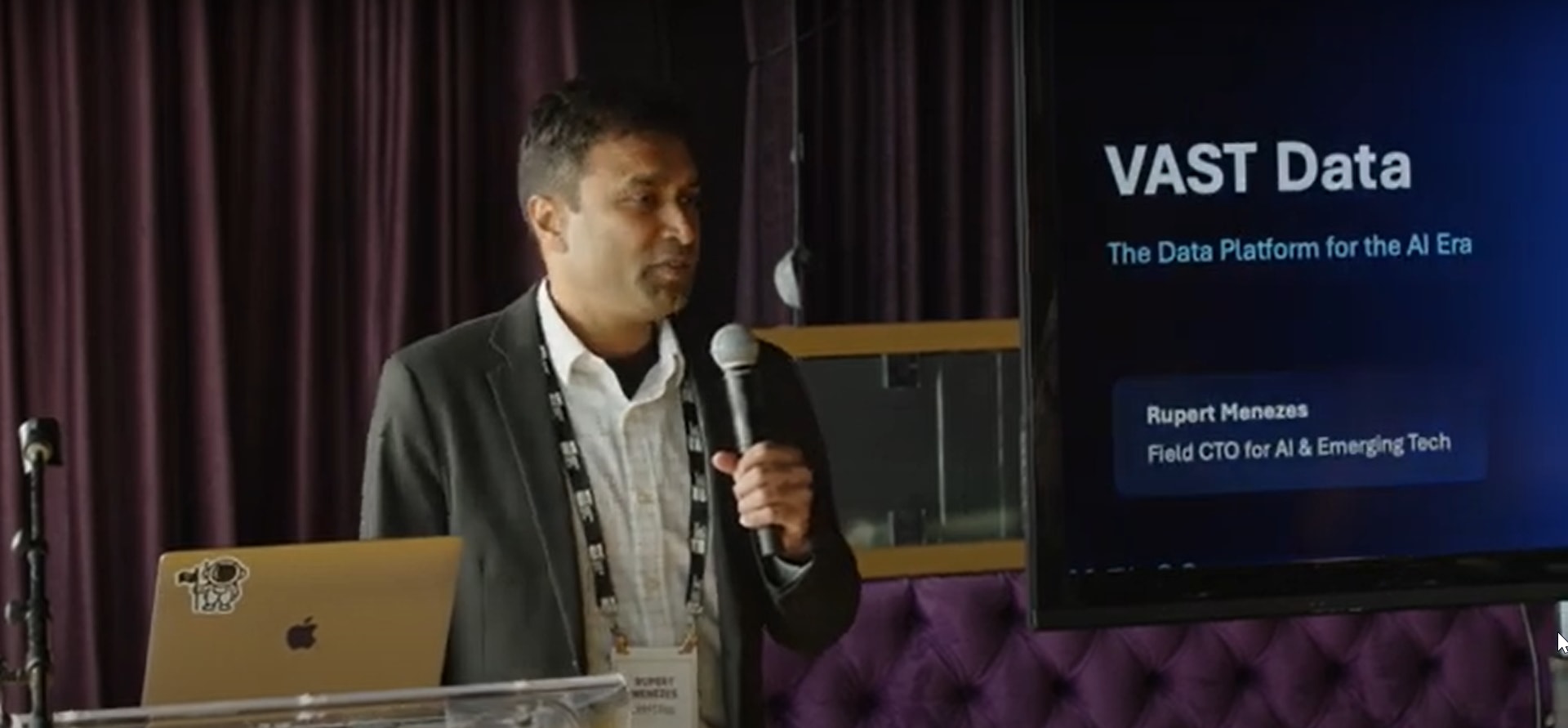June 07, 2023
BTEX 2023: How VAST Data Can Help You Move to All-Flash Storage
Even if you store data in the cloud, there’s a good chance it lives on spinning-disk hardware. VAST Data has emerged as an all-flash data storage alternative.

“We are in the next gold rush or next oil rush, and it's about data,” said Rupert Menezes, Field CTO for AI & Emerging Tech, VAST Data, speaking at CDW Canada’s 2023 Business Technology Expo. “Every single service you have is about data. Every single tech industry that's taken over has built their riches and their infrastructure on data. That's what drives this planet today.”
Why data is staying warmer for longer
In his presentation, Menezes harkened back to the days when it was easy to fill up your 500 MB hard drive by downloading too many MP3 files. “How many of us remember the time where you got to keep certain amounts of data, and then every week you had to delete that data? You didn't get a choice to keep it,” he said.
But now, data doesn’t have to disappear. “Your phones keep getting larger and larger, because you want to keep that data. Why do you want to keep that data? Because it's valuable to you over time. It's valuable for the companies that are providing you the free storage, because they want to mine that data over time.”
So the days of data going cold are no more. “Data no longer starts hot, goes warm and then turns cold. It is hotter, hottest, might turn warm, might change temperatures again. That's about the time VAST Data was formed, because we realized this seismic shift in how everybody was approaching data.”
While data needs have changed, not all infrastructure is keeping up
“How many of your infrastructures run on spinning disk?” Menezes asked the BTEX audience. “How many of you have multiple tiers, a tier of flash for the latest data that your database is running on, then several tiers of spinning disk running around it?”
Menezes mentioned that even if you store data in the cloud, many leading cloud providers are still using spinning disk hardware. “But yet, you don't want spinning disk because you know what's wrong with spinning disk,” he says. “Single stream, not parallel streams. Sequential reads, sequential writes.”
That’s where VAST Data comes in. “We don't have any technical debt. We were founded at a point in time where flash was existing. Everybody had flash devices. NVME was readily available. You can have a NVME fabric.
“In a nutshell, those old technologies that you have deployed are really terrible at taking advantage of flash. Hence, what we've introduced is something called disaggregated shared everything. In the VAST architecture, made up of containers and commercial off-the-shelf hardware, the nodes never talk to each other. They don't need to. Every node knows the entire state of the entire platform at any given time.”
How VAST ensures that no node takes out the entire load
According to Menezes, “You can have a thousand nodes, lose 999 of them, and the system continues to operate. You can then readd the 999 nodes, the nodes never have to talk to each other, and they'll all just spin up and function again.
“And that is the beauty of today, because we didn't invent containers, we just took advantage of them. Our system is based on all flash, and we didn't invent flash, we just took advantage of it. And it's all NVME using Ethernet and IP fabrics, all standard stuff that was already available, we just put it together, and put really smart software on it.
“That really smart software is what takes all of this commercial stuff, and puts it together into an enterprise grade, or a NASA grade system, or a life-depending system of seven or eight nines. So I like to say that we use intelligent software to make dumb hardware intelligent.”
What’s VAST’s value proposition?
“First of all, we're not a storage company, we're a data platform,” Menezes said. “You can come in on any protocol (unstructured protocol, NFS, SMV, objects), you can go out on any protocol you want. The metadata is stored along with it.
“You can send an object in on SMV, you can tag it via S3 API, and then pull it out using NFS or SMV, all simultaneously, on the same data you store. You could store it once, you never have to move it if you don't need to.
“Secondly, we provide an architecture that scales out into the exabyte scale, so we're talking about tens of thousands of protocol servers, servicing millions of clients, that is the scale of our architecture.
“It's a very simple consumption model, you just pay on capacity, there's nothing else you pay for. It's one price, you pay by the terabyte, and that's it. And you don't pay for the savings you get from dedupe, you don't pay for the savings you get from similarity or from compression, that's all gravy for you. You just pay for the usable capacity that you're using at any given time.”
“Forget about unicorns… we’re a centaur.”
According to Menezes, VAST Data is beyond a unicorn startup. “We're one of the elite centaur status startups. We are cash flow positive for the last three years. That means we are a startup that is five years old and we've been cash flow positive for three of them. Go out to any of the startups who have been around for a long time and see if any of them have been cash flow positive that fast or are still cash flow positive.”
